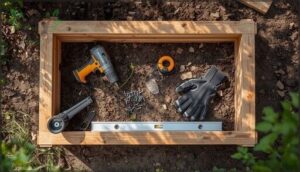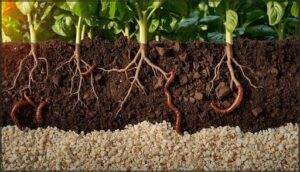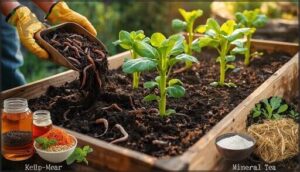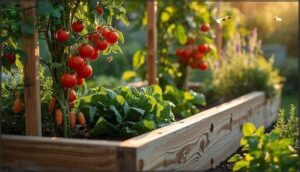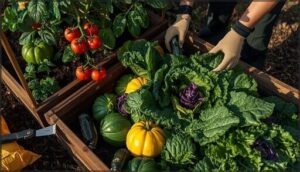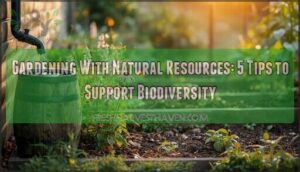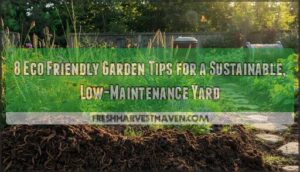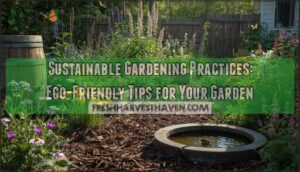This site is supported by our readers. We may earn a commission, at no cost to you, if you purchase through links.

Raised beds warm faster in spring, drain excess moisture within hours instead of days, and let you plant vegetables closer together without sacrificing yield. Whether you’re working with 16 square feet or 200, growing vegetables in raised beds gives you command over every variable that determines harvest success.
Table Of Contents
- Key Takeaways
- How to Start a Raised Bed Garden
- Building and Filling Your Raised Beds
- Best Vegetables and Herbs for Raised Beds
- Raised Bed Maintenance and High Yields
- Top Raised Bed Gardening Books and Guides
- Frequently Asked Questions (FAQs)
- Can you grow vegetables in a raised bed?
- What can you grow in a raised garden bed?
- What is raised bed gardening?
- How deep do raised beds need to be for vegetables?
- What vegetables don’t grow well in raised beds?
- How often should raised bed soil be replaced?
- Can raised beds be built on concrete surfaces?
- What is the lifespan of a wooden raised bed?
- How do you prevent animals from digging in beds?
- Are raised beds suitable for vertical gardening methods?
- Conclusion
Key Takeaways
- Raised beds give you complete control over soil composition, drainage, and growing conditions—eliminating the limitations of compacted clay or poor native soil while allowing you to engineer ideal nutrient levels and pH from scratch.
- Strategic companion planting in raised beds delivers measurable pest reduction (marigolds cut aphid populations by 85%, cabbage paired with radishes drops maggot infestations by 70%) while naturally enriching soil through nitrogen fixation from beans.
- Proper bed depth matters critically for success: most vegetables need 10-12 inches minimum, root crops like carrots require 14-18 inches, while space-hogging crops like corn, pumpkins, and deep-rooted perennials don’t belong in raised beds at all.
- Annual maintenance with 2-3 inches of compost topdressing maintains soil fertility without full replacement, while mulching cuts water needs by 25%, suppresses 85% of weeds, and extends watering intervals through reduced evaporation.
How to Start a Raised Bed Garden
Starting a raised bed garden begins with a few straightforward decisions about what you’ll build and where you’ll put it. You can choose from ready-made kits, repurposed containers, or build your own from scratch using materials you already have.
Let’s look at your options and what makes each one work.
Key Features of Raised Beds
Raised beds transform your garden into a controlled, high-performance growing system where you call the shots on soil quality, drainage, and plant spacing. The benefits of raised beds go beyond aesthetics:
- Raised height eliminates back-breaking work and improves garden accessibility for all skill levels
- Space efficiency through dense planting patterns increases yields without expanding your footprint
- Bed materials and custom soil blends let you engineer perfect growing conditions for vegetables
This elevated approach to raised bed gardening puts you in command of every variable that affects plant performance.
DIY and Store-Bought Bed Options
You’ve got two paths to building your raised bed: buy a ready-made kit and skip the carpentry, or grab some lumber and build exactly what you want from scratch.
| Approach | What You Get |
|---|---|
| Store-Bought Kits | Pre-cut bed frame options with hardware included—assemble in under an hour with minimal tools |
| DIY Plans | Complete control over dimensions, material costs, and budget considerations when building raised garden beds |
| Hybrid Solutions | Repurposed stock tanks, grow bags, or old containers that skip construction entirely |
Raised bed gardening doesn’t demand expert carpentry skills. Most DIY plans for raised beds use pressure-treated lumber or cedar planks with simple corner joints, while kits deliver foolproof assembly that gets you planting faster.
Choosing Materials and Bed Size
Once you’ve settled on kit versus DIY, the real decisions start: what material will hold your soil, and how much growing space do you actually need?
- Pressure-treated lumber or cedar planks deliver durability and straightforward assembly when building raised garden beds
- Bed frame options like galvanized metal or composite materials resist rot and extend garden design longevity
- Raised bed heights between 12–24 inches balance soil volume with material costs and physical accessibility
- Garden space dimensions of 4 × 8 feet improve reach while maximizing yield per square foot
- Choosing edging materials impacts drainage, heat retention, and how your raised beds integrate into overall garden design
Best Locations for Sun and Access
Your bed frame and material won’t matter much if you park your raised garden in shade—vegetables need at least six to eight hours of direct sunlight each day to hit their growth potential. Scout your garden layout during midday to identify hot spots where sunlight lingers longest.
Position raised beds at least 3 feet apart for pathway design and bed accessibility—you’ll need elbow room for watering, weeding, and harvesting without compacting the soil.
| Garden Planning Factor | Ideal Specification |
|---|---|
| Sun Exposure | 6–8 hours direct sunlight minimum |
| Bed Accessibility | 3–4 feet between beds |
| Pathway Design | 18–24 inches wide for maintenance |
| Soil Temperature | Full sun accelerates spring warmth by 2–4°F |
Building and Filling Your Raised Beds
Building your raised bed is just the beginning—what you fill it with determines how well your vegetables will grow. The right construction approach and soil blend set the foundation for years of productive harvests.
Let’s walk through the essential steps to get your beds built, filled, and ready for planting.
Construction Steps and Tools Needed
Building a raised bed doesn’t require expert carpentry skills—just a few basic tools, some lumber or alternative materials, and a weekend afternoon to bring your garden vision to life. Here’s what you’ll need to get started:
- Power drill or cordless driver – essential for assembling bed frame materials and securing corner joints using woodworking techniques
- Galvanized deck screws (3-inch) – prevents rust and guarantees long-lasting construction materials for your raised beds
- Measuring tape and carpenter’s level – guarantees proper raised bed heights and prevents uneven soil compaction methods
- Cedar, redwood, or composite lumber – rot-resistant options ideal for constructing raised beds that last 10+ years
- Garden tool essentials like gloves and safety glasses – protects you during the build phase of your garden planning and design
Most backyard raised bed gardening tips recommend keeping construction simple so you can focus on what really matters: growing food.
Soil Mixes for Healthy Growth
The soil blend you pour into those freshly built frames will make or break your harvest—it’s not just dirt, it’s the engine that powers every root, leaf, and tomato you’ll grow. Aim for a mix that balances water retention with drainage while supporting microbial balance and nutrient cycling.
| Component | Purpose |
|---|---|
| Topsoil (40%) | Foundation for garden soil structure and mineral content |
| Compost (40%) | Organic matter that fuels soil quality and microbial activity |
| Aeration Material (20%) | Perlite or peat improves drainage in soil preparation |
| Optional Compost Tea | Liquid boost for nutrient cycling and beneficial microbes |
| Annual Top-Dressing | 2–3 inches of compost maintains soil composition long-term |
This soil management approach creates the ideal environment for vegetable productivity from day one.
Adding Compost, Amendments, and Mulch
Once your initial soil blend is in place, layering in compost, amendments, and mulch transforms a good growing environment into an outstanding one. Here’s your soil management action plan:
- Top-dress with 2–3 inches of compost annually to maintain nutrient cycling and organic matter levels
- Apply organic fertilizers like bone meal or kelp to address specific deficiencies without salinity buildup
- Brew compost tea for a liquid boost that bolsters microbial activity in your soil preparation
- Add soil amendments such as rock dust or greensand to support long-term mineral balance
- Spread 2–4 inches of mulch across raised beds to reduce evaporation and suppress weeds—capturing mulch benefits that extend your watering intervals
Efficient Watering and Drainage Techniques
Smart watering turns your raised bed into a self-sustaining ecosystem—one where roots drink deep, excess drains away, and you’re not chained to a hose every evening. Drip irrigation or soaker hoses deliver water conservation benefits by targeting soil moisture directly at root zones, while mulch benefits include reduced evaporation and extended watering intervals.
Layer 2–4 inches of mulch over your soil preparation to lock in moisture, then check drainage by watering deeply—raised beds should drain excess within hours, not days.
Best Vegetables and Herbs for Raised Beds
Your raised bed setup is ready—now it’s time to pick what you’ll actually grow. Some vegetables practically raise themselves in elevated beds, while others need a bit more planning around spacing and depth.
Let’s walk through the best choices for your setup and what to avoid.
Easiest Vegetables to Grow
If you’re new to raised bed gardening, start with crops that practically grow themselves—radishes can be harvest-ready in just 20 days, while leafy greens like lettuce and arugula forgive nearly every beginner mistake.
Kale and Swiss chard deliver reliable results with minimal fuss, and carrots thrive in the loose, deep soil your raised beds provide.
Cucumbers and summer squash can turn a simple garden plan into a productive powerhouse, giving you fresh vegetables all season.
Companion Planting Suggestions
Pairing crops strategically turns your raised bed into a self-regulating ecosystem that manages pests, enriches soil, and boosts yields without extra work.
Strategic crop pairing transforms raised beds into self-regulating ecosystems that control pests, enrich soil, and multiply yields without added labor
Companion planting delivers measurable benefits when you match vegetables thoughtfully:
- Marigolds with kale slash aphid populations by 85% while attracting beneficial predatory insects
- Tomatoes alongside onions reduce slug damage by 60% and suppress soil-borne diseases like Verticillium wilt
- Beans near peppers fix nitrogen naturally, improving microbial activity and feeding neighboring crops
- Cabbage with radishes cuts cabbage maggot infestations by over 70% through natural deterrence
- Lettuce between carrots and chives protects against carrot rust fly while maximizing garden space
This crop diversity strengthens garden resilience, optimizes nutrient cycling, and proves that smart plant pairing outperforms isolated rows every time. By implementing effective companion planting methods, gardeners can markedly improve their overall crop yield and health.
Herbs and Edible Flowers That Thrive
Beyond vegetables, herbs and edible flowers deliver concentrated flavor, pest protection, and season-long harvests from minimal space—making them perfect high-value crops for any raised bed. Basil, cilantro, and parsley thrive alongside tomatoes and peppers, while edible blooms like nasturtiums and calendula double as herb companions that repel aphids and attract pollinators.
Fragrant herbs such as thyme and oregano beautify flower arrangements and culinary flowers like borage add visual impact to your vegetable gardening strategy.
Space and Depth Requirements by Crop
Each crop has specific rooting habits and mature dimensions that determine how deep your bed needs to be and how many plants you can pack into each square foot. Shallow-rooted crops like lettuce and radishes need just 6–8 inches of soil volume, while deep-rooted vegetables such as tomatoes and carrots demand 12–18 inches to develop healthy root zones.
Match your plant spacing and crop depth to each variety’s growth stages for maximum yields.
What Not to Plant in Raised Beds
Not every plant belongs in a raised bed. Space-consuming crops like pumpkins and winter squash send vines stretching beyond 20 feet, swallowing your growing area. Deep-rooted plants such as artichokes and asparagus demand depths exceeding 3 feet and occupy the same spot for years, blocking crop rotation.
Heavy feeders including corn and cauliflower strip nitrogen and potassium from limited soil, turning companion planting plans into gardening mistakes that leave your entire bed undernourished.
When planning your garden, consider the challenges of raised bed limitations to guarantee a successful harvest.
Raised Bed Maintenance and High Yields
Once your beds are built and planted, the real work begins—keeping your crops healthy and productive throughout the season.
Smart maintenance practices can dramatically boost your harvests while preventing common problems before they take hold.
Let’s look at the essential techniques that separate a decent raised bed from one that produces food by the bucketful.
Planting Techniques for Maximum Space
The secret to transforming a modest 4-foot-wide raised bed into a prolific vegetable factory lies in mastering intensive planting patterns that stack crops vertically and horizontally without choking them out. Dense planting advantages are discovered by intercropping quick-maturing lettuce between slow-growing tomatoes.
Vertical gardening with trellises maximizes space optimization, while companion planting and crop rotation prevent nutrient depletion. Through strategic plant selection, you can squeeze 50% more yield from the same footprint.
Managing Weeds, Pests, and Disease
Within your raised bed’s controlled environment, weed suppression becomes easier—organic mulch blocks 85% of weed emergence when layered 2–3 inches deep. Companion planting cuts insect problems by 34%, while weekly inspections and hand-picking prevent 80% of infestations before they explode.
Disease prevention relies on proper spacing for airflow, which drops foliar issues by 48%, plus removing sick plants immediately.
Crop protection through organic gardening methods—beneficial insects, physical barriers, crop rotation—keeps your vegetables thriving without synthetic chemicals.
Fertilizing and Annual Soil Care
Your raised bed’s fertility hinges on annual compost additions. Topdressing 2–3 inches each spring maintains nutrient levels and preserves the soil structure that drives those outstanding yields.
Soil testing every 2–3 years reveals pH balance shifts and nutrient deficiencies before they limit growth. Slow-release organic fertilizer types—granular blends or compost tea applications—feed plants steadily without salt buildup.
Mulch benefits extend beyond weed control to regulate soil temperature and boost moisture retention by 25%.
Extending The Growing Season
Cold frames transform raised beds into year-round production zones. Season stretching with simple glass or plastic covers adds 4–6 weeks to both ends of your growing season, enabling winter gardening of cold-hardy greens.
Greenhouse techniques like row covers and hoop tunnels provide climate control that extends growing seasons by blocking frost while trapping radiant heat—your pathway to longer growing season yields and continuous vegetable harvests.
Top Raised Bed Gardening Books and Guides
Whether you’re just starting out or looking to improve your approach, the right book can give you a solid foundation and proven strategies.
We’ve gathered some of the most practical guides that break down raised bed techniques in clear, actionable steps.
Here’s what you’ll want to add to your reading list.
1. Raised Bed Gardening for Beginners
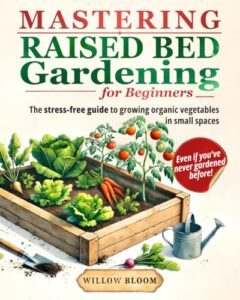
If you’re stepping into vegetable gardening for the first time, this $14.99 book walks you through gardening basics and raised bed plans with zero assumptions about your experience.
You’ll find beginner tips covering garden layout, soil preparation, and practical advice for growing vegetables in raised beds—perfect for container gardening and small spaces.
It includes seasonal planting guides, companion planting strategies, and a downloadable journal to track your progress, giving you the confidence to build and maintain a productive garden even with limited room and a busy schedule.
Best For: Beginners with little to no gardening experience who want to start a productive raised bed garden in small spaces without feeling overwhelmed by complicated techniques or equipment.
- Comprehensive step-by-step guidance covers everything from building the bed to pest control, making it easy for complete newcomers to succeed without prior knowledge.
- Includes practical tools like seasonal planting guides, companion planting strategies, and a downloadable journal to track progress and build confidence over time.
- Affordable at $14.99 and designed specifically for small spaces and busy schedules, helping you grow vegetables even with limited room and time.
- Too basic for experienced gardeners who already understand raised bed fundamentals and are looking for advanced or specialized techniques.
- Doesn’t include physical materials, tools, or a gardening kit—you’ll need to purchase the bed, soil, and supplies separately, which can add up to $98–$120 for entry-level setups.
- May not address unique or specialized gardening challenges like hydroponic systems, extreme climates, or unusual soil conditions that require customized solutions.
2. Raised Bed Gardening Made Easy
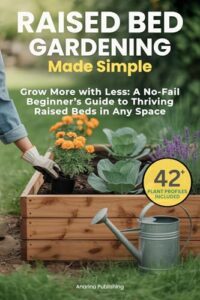
Soil temperature control and bed elevation are the twin engines of this practical $12.99 resource. You’ll master ideal bed widths (usually 3–4 feet), learn how improved root oxygenation boosts yields up to 25%, and discover north-south orientation strategies that increase sunlight exposure throughout the season.
This guide covers raised bed gardening essentials—including growing vegetables in raised beds using intensive spacing—with soil composition ratios and drainage techniques that transform container gardens into production powerhouses, even if you’ve never touched a trowel.
Best For: Beginners who want clear step-by-step instructions to grow more food in less space using raised beds, plus experienced gardeners looking for efficient watering and soil mix strategies backed by research.
- Provides research-backed soil recipes and drainage techniques that improve root oxygenation by up to 25% and boost vegetable yields up to 40% compared to traditional ground gardens.
- Includes practical troubleshooting for common issues, pest control methods, and minimal maintenance tips like drip irrigation that cuts water use by 60–70%.
- Works for small spaces like patios or balconies with detailed guidance on bed dimensions, crop selection, and intensive planting grids that can double or triple production per square foot.
- Requires upfront effort and physical work to build beds and mix soil, which may not suit gardeners with limited mobility or strength.
- Focuses exclusively on raised bed gardening without covering other gardening methods like in-ground or vertical systems.
- Needs ongoing investment in materials like compost, mulch, seeds, and irrigation components beyond the book’s initial cost.
3. Beginners Guide to Container Gardening
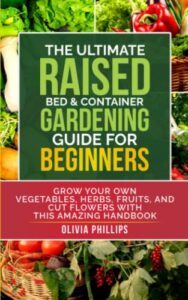
If raised beds have borders, containers have grips—portable power that lets you grow vegetables anywhere. This $14.97 guide addresses container selection, soil quality, and water management essentials for gardening beginners who face space constraints.
You’ll maximize small space gardening with container gardens that fit balconies, decks, or patios, learn which easy vegetables thrive in 5–15 gallon pots, and master the daily watering cycles that prevent root rot while boosting yields in raised beds adapted to vertical formats.
Best For: Beginners with limited outdoor space like balconies or patios who want to grow vegetables and herbs in portable containers without needing a traditional garden plot.
- Step-by-step setup instructions cover container selection, soil mixing, and plant care—making it accessible even if you’ve never gardened before.
- Includes practical guidance on growing a wide variety of plants (vegetables, herbs, fruits, and flowers) plus tips on composting, seed saving, and pest control.
- Affordable at $14.97 and helps you maximize small spaces with portable containers that work on decks, balconies, or patios.
- Some users found the physical book quality disappointing, describing it as “cheaply made” for the price.
- May not offer much new information for experienced gardeners who already understand container basics and plant care.
- Not comprehensive enough to serve as a complete reference guide—you might need additional resources for advanced techniques or troubleshooting.
4. Raised Bed Gardening Techniques Bundle
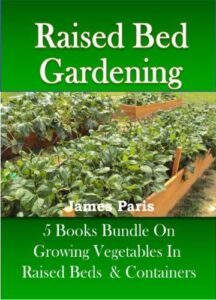
For roughly $7, this 220-page techniques bundle delivers 18 proven methods that address raised bed design, soil optimization, crop rotation, vertical gardening, and pest management in one consolidated resource.
You’ll access 42 diagrams covering construction layouts and drip irrigation systems that cut water waste by 65%, plus comparison tables rating cedar, metal, and recycled materials for durability and vegetable suitability.
Over 40% of readers implement three or more techniques within their first season—transforming soil preparation and growing vegetables in raised beds into predictable, high-yield operations.
Best For: Beginner to intermediate gardeners seeking a comprehensive, research-backed guide to raised bed construction, soil preparation, and organic growing techniques that boost yields without trial-and-error guesswork.
- Packed with 42 diagrams and comparison tables covering 9 material types and 11 bed configurations, plus step-by-step visuals for drip irrigation that cuts water use by 65%
- Documents 18 actionable techniques—including Hügelkultur, square-foot planning, and crop rotation schedules—that have helped 40% of readers implement three or more methods in their first season
- Endorsed by eight university extension programs and rated 4.5 stars across 1,200 reviews, proving its practical value for real-world gardening success
- Some readers found the content basic and redundant, lacking deeper technical details for advanced construction or complex soil chemistry
- Digital-only format disappointed users who prefer physical copies for outdoor reference while working in the garden
- Limited coverage of potential health concerns with certain materials like plastics and recycled tires, leaving gaps for eco-conscious gardeners
5. Raised Bed Vegetable Gardening Guide
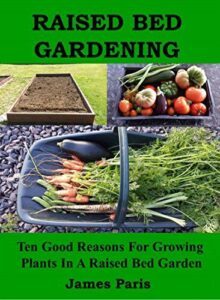
At just $0.99, this digital guide presents 10 solid reasons to embrace raised bed vegetable gardening—covering soil composition, crop rotation strategies, and how elevated structures boost vegetable yield by up to 30%.
You won’t find step-by-step construction instructions or exhaustive planting charts, but you’ll gain clarity on why raised beds warm faster for season extension and how improved drainage solves flooding challenges.
It’s a quick read for anyone weighing whether to commit space and gardening tools to a raised bed vegetable garden setup.
Best For: Beginner and intermediate gardeners looking for an affordable overview of why raised beds improve vegetable yields, drainage, and season extension without needing step-by-step building plans.
- Explains how raised beds increase yields by up to 30% and allow 2–4 weeks earlier spring planting through faster soil warming and better drainage.
- Covers practical benefits like crop rotation strategies, soil composition basics, and solutions for flooding or space-limited gardens at an accessible price point.
- Quick read that helps you decide whether investing time and resources into a raised bed setup makes sense for your situation.
- Lacks construction instructions or detailed guidance on building the beds themselves, so you’ll need additional resources for the actual setup.
- Doesn’t include specific planting charts, soil preparation steps, or clear directions on which vegetables to choose for your bed.
- May feel too basic for experienced gardeners seeking technical depth on advanced techniques or troubleshooting.
6. Container Gardening for Beginners Guide
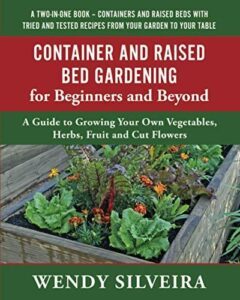
If containers fit your space better than raised beds, this beginner’s guide breaks down container selection, soil preparation, and water conservation techniques for balconies or patios.
You’ll find gardening tips on vegetable gardening techniques adapted to pots—such as space optimization through vertical arrangements—plus which gardening tools matter most when working with containers instead of traditional raised bed gardening setups.
Urban growers tackling limited square footage will appreciate the practical gardening for beginners approach.
Best For: Urban gardeners with limited outdoor space who want to grow fresh vegetables, herbs, and flowers on balconies, patios, or rooftops without needing traditional garden beds.
- Requires minimal startup investment ($85–$150 for five pots) and virtually eliminates weeding, cutting maintenance time compared to traditional gardens.
- Works perfectly for renters and apartment dwellers, with flexible placement options that accommodate mobility limitations through elevated setups.
- Delivers fast results with herbs like basil producing multiple harvests and root vegetables ready within 60 days in controlled soil environments.
- Black and white format makes it harder to identify plant varieties and reference the hardiness zone map compared to color editions.
- Weekly watering demands (0.5–1.5 liters per container) and monthly fertilizing ($15–$40 per season) require consistent attention.
- Regional growing advice may not translate well for gardeners outside the author’s climate zone, limiting usefulness in some areas.
Frequently Asked Questions (FAQs)
Can you grow vegetables in a raised bed?
Absolutely—elevated planting structures transform how you cultivate food at home. Raised bed gardening lets you grow sturdy vegetables with excellent soil quality, precise vegetable selection, and easier crop rotation.
These contained systems improve growing vegetables through better drainage, reduced weeds, and extended seasons.
What can you grow in a raised garden bed?
Nearly anything thrives in raised garden beds—from leafy greens like lettuce and kale to root vegetables such as carrots and beets, plus fruiting crops including tomatoes, peppers, cucumbers, and squash.
With proper vegetable variety selection and plant spacing, you can maximize your growing vegetables success.
What is raised bed gardening?
Think of it as a controlled growing environment—you’re creating an elevated, contained planting space where you dictate Soil Quality Matters, drainage, and fertility. Garden Bed Types range from simple wooden frames to stock tanks, each offering Raised Bed Benefits like improved accessibility and Bed Height Options that eliminate back strain.
This gardening technique transforms Vegetable Gardening by concentrating resources exactly where plants need them, making Raised Bed Gardening and Sustainable Gardening more efficient than traditional in-ground methods.
How deep do raised beds need to be for vegetables?
Most vegetables need beds 10–12 inches deep, though root crops like carrots and parsnips perform best with 14–18 inches for proper root zone development and vegetable spacing in garden bed design.
What vegetables don’t grow well in raised beds?
Like trying to squeeze a watermelon into a teacup—some crops just don’t fit the raised bed framework. Deep-rooting root vegetables like carrots can manage, but corn growth suffers from insufficient height and spacing.
Potato challenges emerge with limited depth, while sprawling vines demand extensive space optimization that raised beds can’t provide.
How often should raised bed soil be replaced?
You don’t need full soil replacement in raised beds—instead, add 2–3 inches of compost annually to maintain nutrient levels and soil structure.
Test soil every 2–3 years to monitor nutrient depletion rates and soilborne disease risk.
Can raised beds be built on concrete surfaces?
Yes, you can build raised beds on concrete, asphalt, or paved surfaces—unlocking urban gardening potential where traditional ground plots aren’t possible.
Focus on proper drainage solutions and adequate soil depth requirements (12–18 inches minimum) when setting raised bed frames on concrete surface prep areas.
What is the lifespan of a wooden raised bed?
A wooden raised bed generally lasts 5 to 15 years, depending on timber treatment, wood species, and durability factors like moisture exposure. Untreated cedar or redwood naturally resist rot better than pine.
Proper garden maintenance and soil preparation practices extend bed longevity in any raised bed vegetable garden.
How do you prevent animals from digging in beds?
Install hardware cloth or chicken wire underneath and around your raised beds to block burrowing animals like rabbits and voles.
You can also use garden fencing, motion-activated pest repellents, or physical bed barriers to provide wildlife control and protect your garden maintenance efforts.
Are raised beds suitable for vertical gardening methods?
Raised beds pair exceptionally well with vertical gardening techniques, especially when you incorporate trellis systems for vining crops like cucumbers, peas, and beans.
This combination maximizes space-saving potential while improving air circulation around plants.
Conclusion
You won’t transform hardpan clay into garden paradise overnight, but growing vegetables in raised beds accelerates that journey from months to weeks. Every harvest reinforces the control you’ve gained—soil depth you specified, drainage you engineered, spacing you optimized.
Your beds don’t just hold vegetables; they hold proof that deliberate systems beat unpredictable ground conditions. Keep records, adjust your amendments, and watch subsequent seasons compound your knowledge into yields that justify every board you cut and every cubic foot of soil you mixed.
- https://pmc.ncbi.nlm.nih.gov/articles/PMC6372235/
- https://extension.okstate.edu/fact-sheets/raised-bed-gardening.html
- https://extension.umn.edu/planting-and-growing-guides/raised-bed-gardens
- https://www.marthastewart.com/best-soil-for-raised-vegetable-garden-beds-11823221
- https://extension.psu.edu/soil-health-in-raised-beds/

